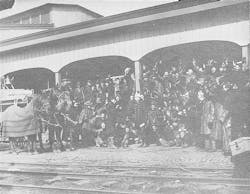CRANFORD, NJ: FEB. 3, 1912 – It was just after 3 o’clock in the morning when A.O. Hopkins, an upholsterer who lived in second-floor rooms in the Opera House, the largest building in town, found heavy smoke in the hallways and woke the janitor, Louis Nahf, who was also a fireman. Nahf immediately turned in the alarm to the local combination paid and on-call fire department. Realizing the advanced stage of the fire upon arrival, Chief Louis Hess requested help from Westfield and Elizabeth. In addition to a large auditorium, the Opera House housed stores and offices. At the height of the fire, an explosion inside a hardware store rocked the block. Firemen continued bravely battling the blaze and confined the fire to the original building, saving nearby homes and structures.
ALPHA, NJ: FEB. 4, 1912 – Fire threatened to destroy the entire town as flames gutted five two-story buildings. Three children burned to death as the fire swept through the structures. With no water supply or fire protection, the townspeople were helpless to stop the blaze.
PHILADELPHIA, PA: FEB. 4, 1912 – A fire that started in a factory at Franklin and Vine streets communicated to the adjoining box factory. The two buildings quickly filled with flames and radiant heat ignited the Majestic Hotel across the street. A general alarm brought 48 engines to the scene as the fire swept into three theatrical boarding houses and moving picture and vaudeville houses. Actors along the row of boarding houses filled trunks with their belongings and hurried into the street. It was feared the fire would take the entire block, but exhausted firemen stopped the spreading flames.
MOLINE, IL: FEB. 6, 1912 – Two firemen were injured battling a blaze in a mill machinery works. The fire began in a boiler room and spread to piles of shavings nearby. Workers attempted to enter the burning mill to retrieve their tools, but were driven back by the heat. The two firemen were injured when a smokestack fell on them. The blaze left 400 people without jobs and the business owners lost a half-million dollars.
JENKINTOWN, PA: FEB. 6, 1912 – A large house at Spring Avenue and York Road caught fire and required the response of the local city firemen and help from adjacent communities. The flames were spreading quickly, pushed by a strong wind. Firemen struggled for more than two hours to gain the upper hand. Valuable paintings were damaged by smoke and water.
NEW YORK CITY: FEB. 9, 1912 – Seven firemen were overcome by gas while battling a fire in a subcellar of a building at William and Spruce streets. The subcellar was being used as the pressroom for the weekly German-language newspaper Staats-Zeitung. The flames caused gas pipes to leak and the accumulating gases knocked the attacking firemen unconscious. Rescuers had great difficulty entering the gas-filled rooms, but dragged the trapped men out one by one. Several of those saved had to be resuscitated in the street.
PITTSFIELD, MA: FEB. 9, 1912 – The second major fire in two weeks brought the entire fire department to the business section of town during the night. The fire, sparked by defective wiring, broke out on the second floor of a furniture store and spread rapidly. Faced with near-zero temperatures, firemen struggled as the fire jumped from building to building. In all, five stores were destroyed and three people were injured.
OGDENSBURG, NY: FEB. 11, 1912 – Firemen rolled out to a fire at a jewelry store with temperatures of 20 degrees below zero. For eight hours, the ice-encrusted firemen battled the flames and severe temperatures. Flames swept the entire block of buildings, including jewelers, legal firms, an optician, a real estate office, a Masonic Temple, a dry-goods store and a five-and-dime store.
MONTREAL, QUEBEC: FEB. 13, 1912 – A man lost his life and four girls were overcome by smoke after a fire and explosion occurred in the basement of a plumbing company at Craig and St. Antoine streets. The victims were working in separate offices above on the second floor when the blaze started. Most were affected by the dense smoke, but several received severe burns as well.
CHARLES CITY, IA: FEB. 18, 1912 – The Hart-Parr Traction Engine Co., maker of motorized tractors, suffered its second large fire of the year as flames from a foundry oven spread to the building. The company lost its powerhouse to a fire a month earlier.
ST. PAUL, MN: FEB. 19, 1912 – A fire was discovered in the Grand Opera House at Sixth and St. Peter streets at 1:40 A.M. Firemen battled the stubborn blaze for more than a hour. Members were operating a hose from a ladder when the ladder suddenly fell. Lieutenant John Thome of Engine 9 was killed and Pipeman Miles McDonahugh was seriously injured.
HOUSTON, TX: FEB. 21, 1912 –A fire that began in an untenanted rooming house and driven by gale-force winds spread with amazing speed. A dozen industrial plants, 200 dwellings and stores of 55,000 bales of cotton were soon in flames. Also engulfed were 36 Southern Pacific railcars. A path of destruction 1½ miles long and a half-mile wide burned across the city. Flaming shingles rained across the city and firemen struggled to halt the marching wall of flames. Time after time, the roof of the oil plant caught fire, but was extinguished. When the smoke cleared, the worst fire in the history of the city had destroyed more than $7 million in property and left 1,000 people homeless.
BALTIMORE, MD: FEB. 22, 1912 – A fire was reported in the main storehouse of the B&O Railroad at 1:15 A.M. With a strong wind fanning the flames, the Mount Claire Shops were soon blazing out of control and second, then third alarms were transmitted. As firemen moved in to douse the blaze, stored dynamite inside the building exploded. The structure was immediately engulfed in flames and was in smoldering ruins in short order.






